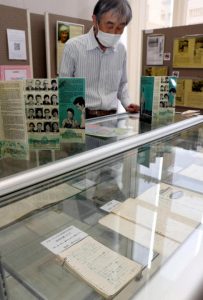Commemorating 60 years since World Peace Pilgrimage, panel exhibit in Hiroshima’s Naka Ward remembers A-bomb survivors and the others
Apr. 8, 2024
by Gosuke Nagahisa, Staff Writer
On April 7, a panel exhibit titled “Hiroshima–Nagasaki World Peace Pilgrimage” opened to the public at the Gojinsha Wendy Hito-Machi Plaza, located in Hiroshima’s Naka Ward. The exhibit tells the story of the pilgrimage, during which A-bomb survivors traveled around the world in 1964, amid the U.S.-Soviet Cold War period, to communicate the reality of the atomic bombings. The exhibit was planned by the World Friendship Center (WFC), an NPO based in Hiroshima’s Nishi Ward, to coincide with the 60th anniversary of the peace pilgrimage. The exhibit is scheduled to continue through April 14. Admission is free.
Around 40 people, including 25 A-bomb survivors, participated in the pilgrimage, which involved visits to 150 cities in eight countries including the United States and the Soviet Union over a period of 75 days, recounting their experiences in the atomic bombings. The panel exhibit has on display 67 items, including a letter of intent from a pilgrimage working group calling for the participation of A-bomb survivors, as well as newspaper articles that covered the pilgrimage at that time.
The exhibit also includes notes from A-bomb survivor Hiromu Morishita that reveal his impressions of a meeting he had in the United States with Harry Truman, the U.S. president at the time of the atomic bombings. Referring to the president, Mr. Morishita wrote, “He didn’t say anything that resembled an apology.” Also on display is a journal written by Shizuko Abe, who shared her A-bombing experiences in the cities she visited during the pilgrimage.
The WFC organization was established by the late Barbara Reynolds (who died in 1990), an American peace activist who initially proposed the pilgrimage. Shizuo Tachibana, 68, current WFC chair, said, “We hope the exhibit will give visitors the opportunity to consider the role of the A-bombed Hiroshima by learning about those times.” Tamiyuki Okahara, 85, a resident of Hiroshima’s Nishi Ward who was visiting the exhibit, said, “I was able to get a sense of Barbara’s strong will. I want to pass on her wishes to future generations.”
(Originally published on April 8, 2024)
On April 7, a panel exhibit titled “Hiroshima–Nagasaki World Peace Pilgrimage” opened to the public at the Gojinsha Wendy Hito-Machi Plaza, located in Hiroshima’s Naka Ward. The exhibit tells the story of the pilgrimage, during which A-bomb survivors traveled around the world in 1964, amid the U.S.-Soviet Cold War period, to communicate the reality of the atomic bombings. The exhibit was planned by the World Friendship Center (WFC), an NPO based in Hiroshima’s Nishi Ward, to coincide with the 60th anniversary of the peace pilgrimage. The exhibit is scheduled to continue through April 14. Admission is free.
Around 40 people, including 25 A-bomb survivors, participated in the pilgrimage, which involved visits to 150 cities in eight countries including the United States and the Soviet Union over a period of 75 days, recounting their experiences in the atomic bombings. The panel exhibit has on display 67 items, including a letter of intent from a pilgrimage working group calling for the participation of A-bomb survivors, as well as newspaper articles that covered the pilgrimage at that time.
The exhibit also includes notes from A-bomb survivor Hiromu Morishita that reveal his impressions of a meeting he had in the United States with Harry Truman, the U.S. president at the time of the atomic bombings. Referring to the president, Mr. Morishita wrote, “He didn’t say anything that resembled an apology.” Also on display is a journal written by Shizuko Abe, who shared her A-bombing experiences in the cities she visited during the pilgrimage.
The WFC organization was established by the late Barbara Reynolds (who died in 1990), an American peace activist who initially proposed the pilgrimage. Shizuo Tachibana, 68, current WFC chair, said, “We hope the exhibit will give visitors the opportunity to consider the role of the A-bombed Hiroshima by learning about those times.” Tamiyuki Okahara, 85, a resident of Hiroshima’s Nishi Ward who was visiting the exhibit, said, “I was able to get a sense of Barbara’s strong will. I want to pass on her wishes to future generations.”
(Originally published on April 8, 2024)








